research
My research interests lie at the interface of radio observations and theory of high redshift galaxy and structure formation, with data analysis and machine learning applications acting as a bridge. Broadly, I am interested in star and galaxy formation, large scale structure, and cosmological data analysis. I am particularly interested in the development of analysis pipelines for intensity mapping experiments, and the robust connection of data to cosmological models. See below for some of my recent and ongoing projects and their selected publications. See my ADS library for a full list of publications. Scroll to the bottom for some of my selected talks.
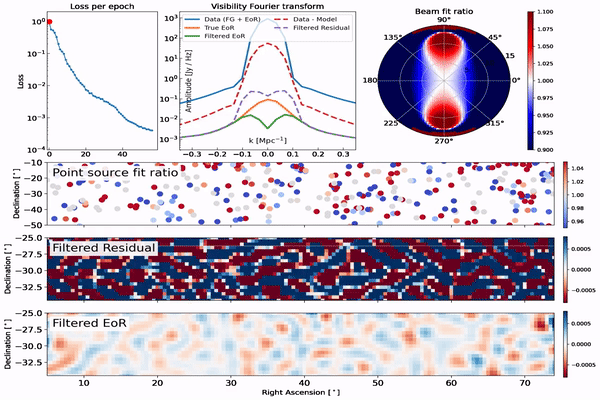
Mock foreground and instrument optimization, revealing an underlying cosmological 21 cm signal.
The BayesLIM Project
Kern 2025 | MNRAS, 541, 687 | arxiv:2504.07090
The BayesLIM project is developing the first end-to-end, differentiable Bayesian forward model for line intensity mapping (LIM) cosmology, with a specific focus on 21 cm cosmology. BayesLIM is a multi-purpose tool, aiming to replace many standard LIM analyses with an equivalent Bayesian forward model counterpart. It leverages automatic differentiation and GPU acceleration to make the otherwise computationally intensive end-to-end Bayesian approach feasible. In the paper above, we show how it can enable, for the first time, joint posterior density estimation between the 21 cm signal, bright contaminating astrophysical foregrounds, and a complex instrumental response function. These tools will be key to making robust, direct detections of the 21 cm cosmological signal with next-generation LIM experiments.
Click on the title above to learn more.

Improved Limits on the 21 cm EoR Power Spectrum from HERA Phase I
HERA Collaboration 2022a (lead author: Kern) | ApJ, 925, 221 | arxiv:2108.02263
The Hydrogen Epoch of Reionization Array (HERA) is a new radio interferometer that aims to detect the 21 cm signal from cosmic hydrogen at the Epoch of Reionization and Cosmic Dawn. I led the first analysis of HERA Phase I observations, which set world-leading constraints on the EoR power spectrum (pink triangles) in 2022. Our z=8 limits improved upon existing limits by over an order of magnitude in sensitivity. These gains were due largely by my analysis pipeline’s careful accounting of systematics, and the development of new tools for systematic mitigation that I led (see below). Read more about this result at MIT news.
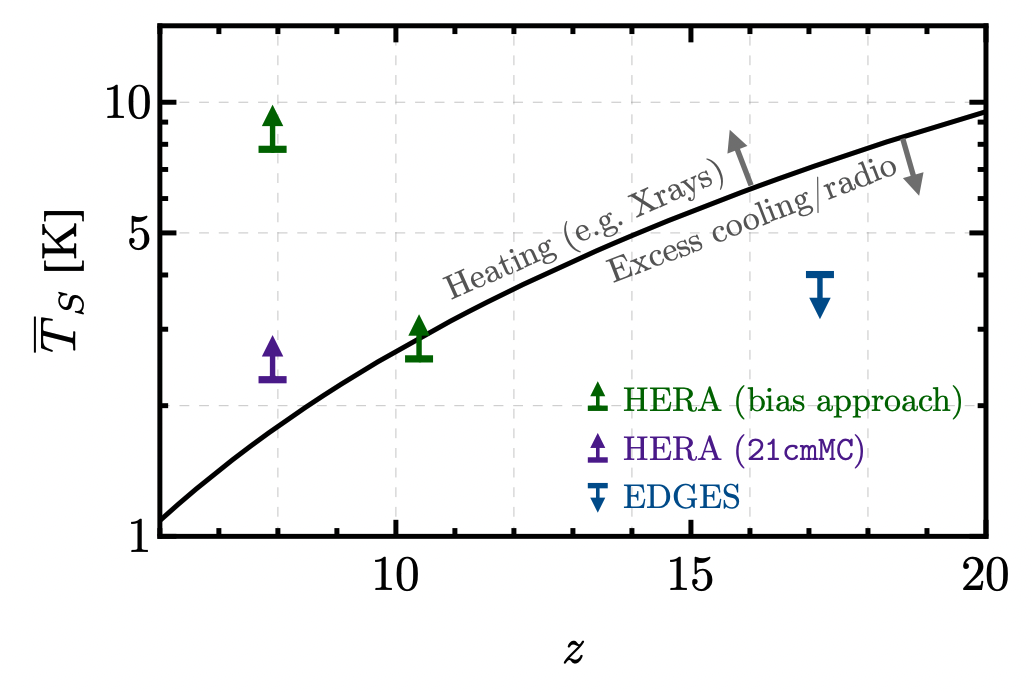
HERA limits on the EoR 21 cm power spectrum (top; pink) and their implied constraints on the IGM temperature at z > 8 (bottom).
HERA Collaboration 2022b | ApJ, 924, 51 | arxiv:2108.07282
This companion paper used a suite of theoretical methods to interpret HERA’s first power spectrum upper limits and set constraints on the properties of the intergalactic medium (IGM) at redshifts 8 and 10.4. Principally, this analysis shows that the HERA limits require the IGM to be heated above its adiabatic cooling limit by z=8 (purple arrow). This implies that early X-ray sources from the first galaxies (e.g. from high-mass X-ray binaries) must have been more luminous than their local-universe analogues, and is consistent with a population of low-metallicity HMXB. This is the most stringent constraint on the X-ray properties of compact objects at Cosmic Dawn to date.
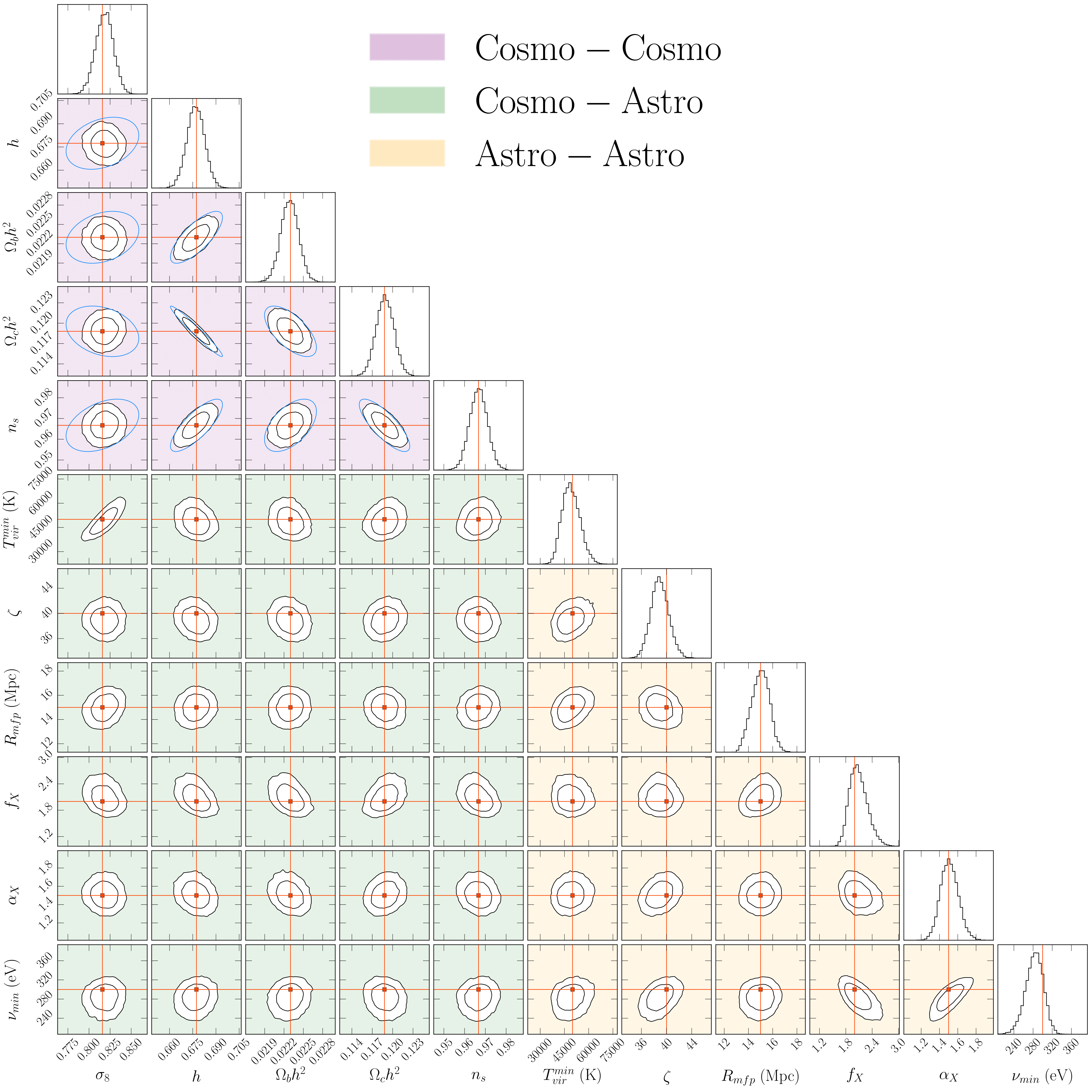
Emulated posterior distributions on LCDM, EoR star formation and Cosmic Dawn X-ray heating parameters with a 1000-hour mock HERA observation.
Cosmic Dawn Parameter Inference with Emulators
Kern et al. 2017 | ApJ, 848, 23 | arxiv:1705.04688
Connecting data to theoretical predictions from sophisticated and compute-intensive simulations is often prohibitively expensive. A solution is to use machine learning methods to emulate the mapping of the simulation’s input parameters to its output products with a less computationally expensive surrogate model. We explored this in the context of a cosmological 21 cm simulation, paying careful attention to the problem of propagating emulator uncertainty. Leveraging emulator acceleration, this work demonstrated for the first time a joint parameter forecast across both cosmological and astrophysical Cosmic Dawn parameters. Since this work, nearly all current 21 cm Cosmic Dawn inference packages have gone on to adopt similar emulator techniques.
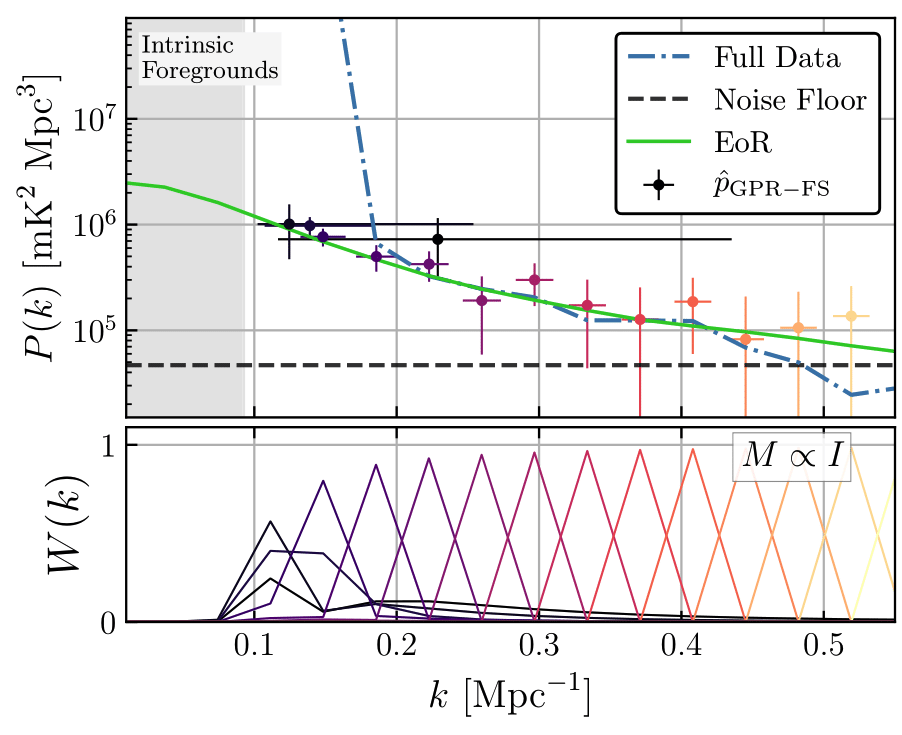
Simulated recovery of the 21 cm power spectrum with Gaussian process modeling, showing that without careful normalization it is difficult to recover the power spectrum robustly (i.e. large horizontal errorbars).
Understanding the Limits of Gaussian Process Based Foreground Subtraction
Kern & Liu 2021 | MNRAS,501,1463K | arxiv:2010.15892
The scientific potential of 21 cm cosmology is currently hindered largely by bright galactic and extragalactic foreground emission. Many techniques have been proposed to model and subtract such foregrounds, although none of proven sufficient on real data to yield a detection of the 21 cm power spectrum. In this paper, we revisit a popular technique for foreground modeling using Gaussian processes (GP), and show that such a data model is in fact closely related to the widely studied inverse covariance model used in CMB and optical galaxy surveys. Furthermore, we show that improper normalization of a GP-based data model can lead to non-negligible bias in the recovered power spectrum. We show how one can mitigate this bias by compromising overall sensitivity.
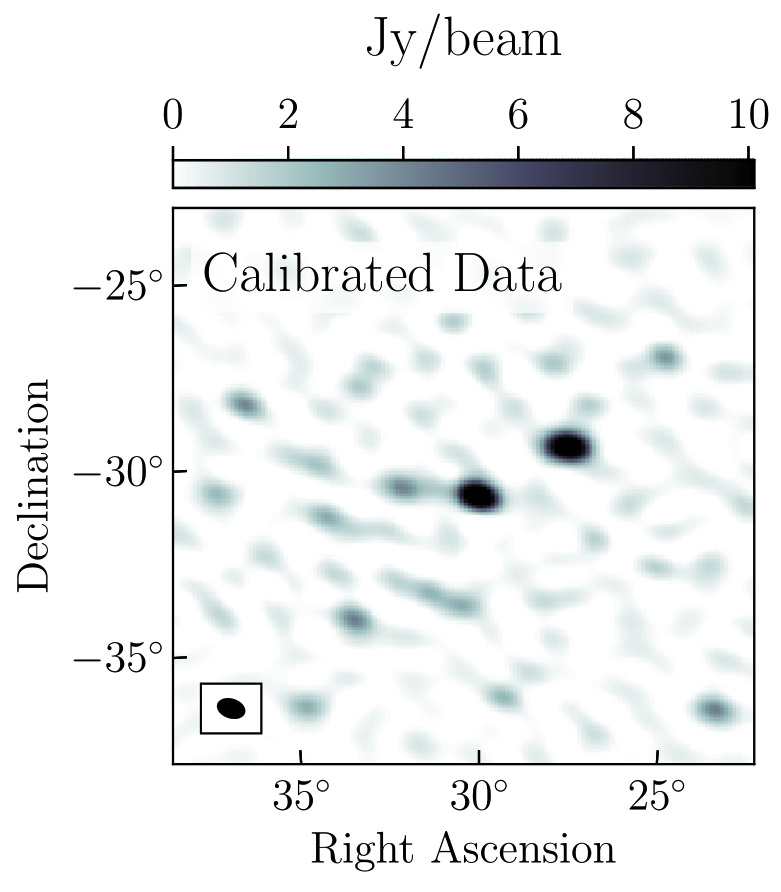
A calibrated HERA image of the radio sky, showing a collection of radio galaxies.
HERA’s Analysis Pipeline
I’ve spent considerable work building a custom analysis pipeline for the unique challenges faced by the HERA 21 cm telescope. This includes a precision calibration pipeline, and careful data models that isolate systematics from the cosmological signal in our data.
Absolute Gain Calibration for HERA, Kern et al. 2020b | ApJ, 890, 122 | arxiv:1910.12943
Precision calibration is fundamental to 21 cm science. In this paper, we investigate various approaches for calibration of the HERA receivers, including sky-based and hybrid redundant & absolute calibration schemes. For foreground avoidance power spectrum estimators, we show that HERA can be well-calibrated with a small number of degrees of freedom across time and frequency. We also show that, when not handled properly, calibration can actually excerbate inherent instrumental contaminants in the data. We further describe calibration gain smoothing techniques for mitigating this effect. These considerations are particularly important for radio experiments with redundant and closely packed antennas like HERA.
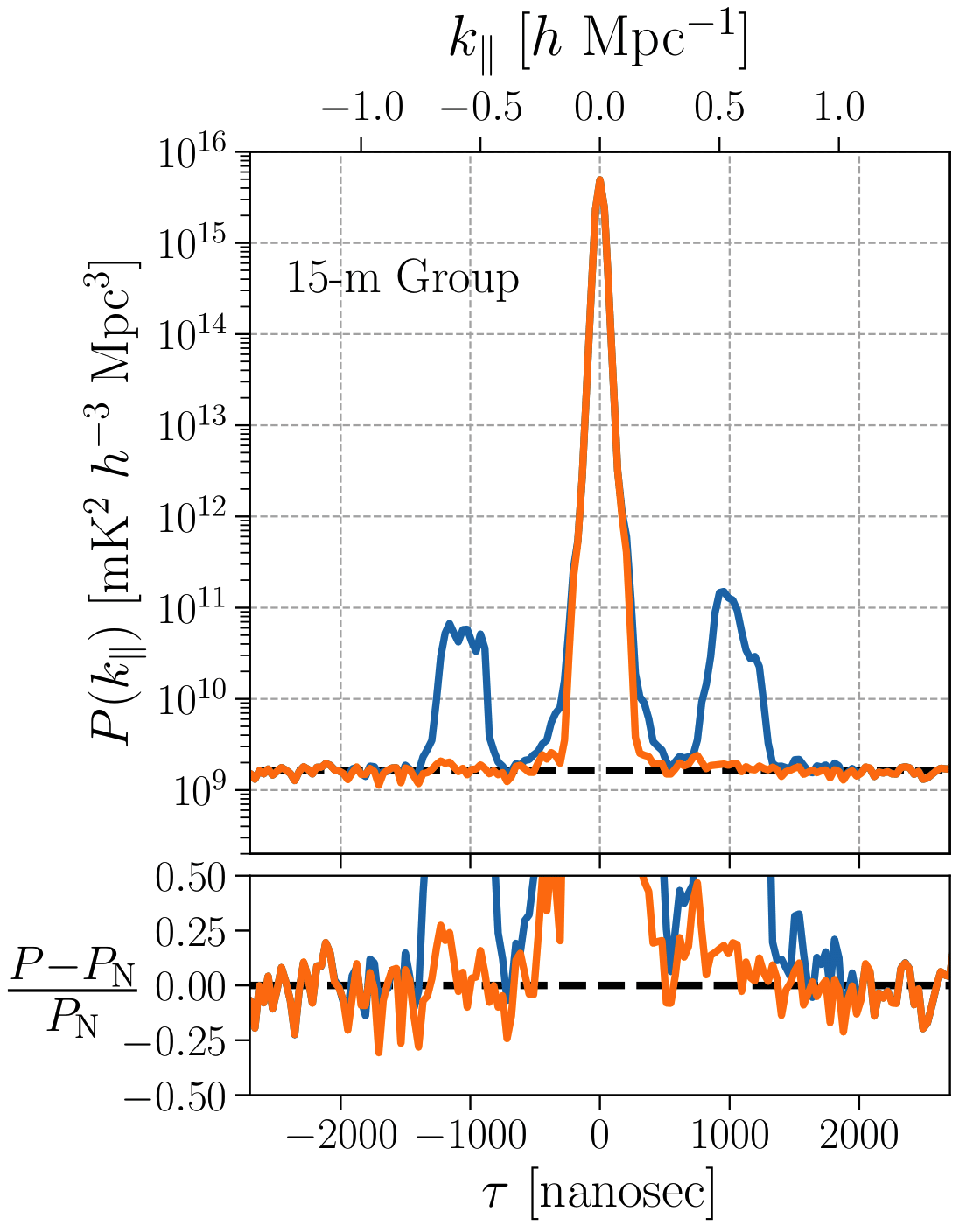
HERA power spectra before (blue) and after (orange) systematics modeling and subtraction, showing nearly two orders of magnitude reduction in power.
Mitigating Intstrumental Coupling I, Kern et al. 2019 | ApJ, 924, 51 | arxiv:1909.11732
Mitigating Intstrumental Coupling II, Kern et al. 2020a | ApJ, 924, 51 | arxiv:1909.11733
Instrumental systematics are a persistent problem for 21 cm radio telescopes, and fundamentally limit the scientific potential 21 cm science. In this paper, we analytically describe the phenomenology of common radio instrumental systematics like cable reflections and crosstalk that are particularly pertinent for HERA. We propose novel algorithms for modeling and removing these systematic in the data, and use numerical visibility simulations to validate their performance and demonstrate their resistance to signal loss. In a follow-up paper, we demonstrate the effectiveness of these techniques in real HERA data (left), showing over an order of magnitude suppression in systematics in deep HERA observations (orange line). This was a crucial enabling factor for HERA’s recent world-leading constraints on the EoR power spectrum. These techniques have also since gone on to inform systematic models for other 21 cm telescopes.
Some of my selected talks
“New Insights on Cosmic Dawn Astrophysics from Radio Measurements” | NASA Hubble Research Symposium, 2023
“Pushing Inference to the Sky: Differentiable Forward Modeling for Radio Telescopes” | Berkeley 21 cm Global Signal Conference, 2022
“Revisiting Gaussian Process Regression for Radio Cosmology” | Science at Low Frequencies Conference, 2020
“Surrogate Modeling for Accelerating Semi-Numerical Cosmological Parameter Inference” | Science at Low Frequencies Conference, 2016